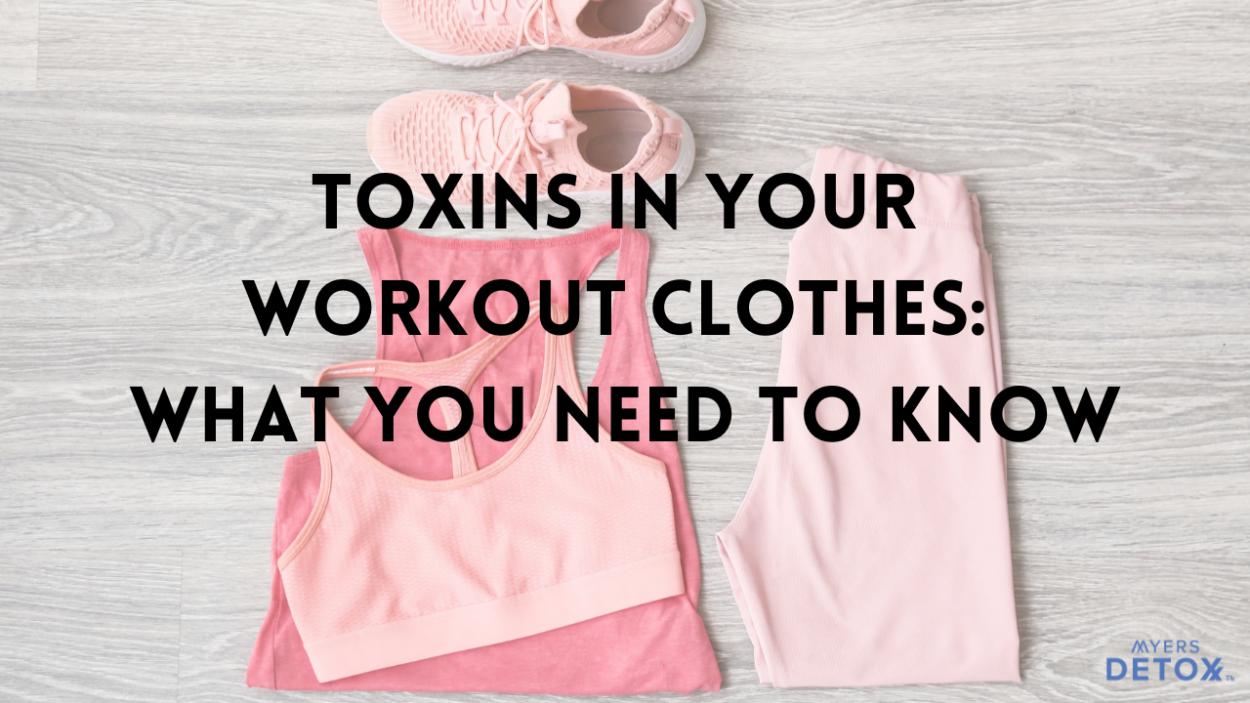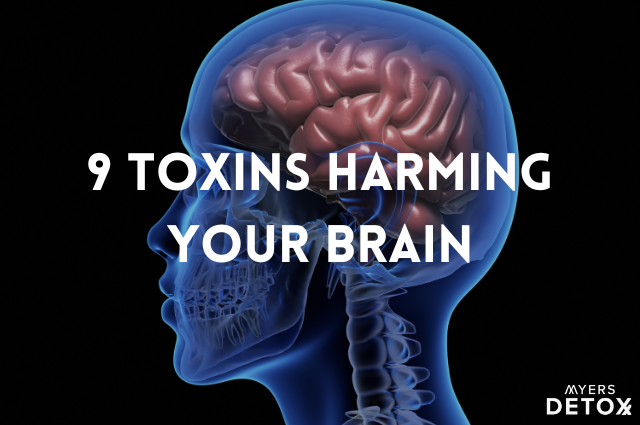One of the primary reasons people exercise is to achieve or maintain optimal physical health. Physical activity can help you lose weight, get strong, maintain cardiovascular fitness, and so much more.
But what if your workout clothes are working against you? What if your workout clothes contain toxins like BPA and PFAS (forever chemicals)?
By now, most people are aware of the potential toxins in our food supply, but what about the toxic compounds in our textiles? Before you reach for your favorite workout pants, read this article.
We’ll discuss:
- Which of the popular athletic wear brands may be compromised with toxins (hint: it’s most of them)
- Why BPA and PFAS should be avoided at all costs, especially if you’re worried about hormone health
- How even small amounts of these chemicals can cause massive harm
- The best way to reduce your exposure to these compounds so you can exercise in peace
BPA and PFAs In Your Exercise Clothes
Most people associate BPA (Bisphenol A) with plastics – water bottles, food containers, plastic bags, canned foods, and so on. What you may not realize, however, is that this chemical is used widely in several industries, including the fashion industry.
Back in 2022, a nonprofit consumer advocacy group called the Center for Environmental Health (CEH) tested several brands of activewear to assess toxic chemicals in the fabric, and what they found was disturbing, to say the least[1].
The CEH detected high levels of BPA in sports bras, shirts, leggings, and other forms of activewear. And if you’re thinking that these results must have come from low-quality brands – think again. Their assessment included some of the most popular activewear brands, such as Patagonia, Athleta, PINK, Nike, and The North Face (among others).
Why are these companies adding BPA, a known endocrine-disrupting chemical, to their clothes? One reason is that BPA may help textiles maintain color-fastness by fixing the dyes. BPA can also act as an anti-static agent, fungicide, and flame retardant.
And if that wasn’t bad enough, BPA isn’t the only harmful chemical that’s been identified in clothing. Per- and poly-fluoroalkyl substances (PFAS) may also be added to your clothes for their water and stain-resistant properties. If you’re unfamiliar, PFAS are also known as “forever chemicals” due to the fact that they don’t break down in the environment. That’s right; these toxic compounds just keep accumulating over time, creating dangers not only for our physical health but for the planet’s health.
At this point, you may be asking yourself how concerned you should be about these toxic compounds in your body. Sure, you know that ingesting toxins can be dangerous, but what’s the harm in wearing them?
According to Alden Wicker, author of the book To Dye For: How Toxic Fashion Is Making Us Sick – and How We Can Fight Back, we should be very concerned. Not only are these compounds unsafe for our environment, but there is currently no “safe” dose for these chemicals[2]. That means that even if only a small amount of BPA or PFAS is absorbed through your skin, it could cause serious damage to your body.
Now you may be wondering where legal regulation comes in – we must have some standards set in place to ensure the safety of consumers, right?
Not so much.
In the US, the standards for clothing are incredibly loose and primarily voluntary.
The Dangers of BPA and PFAs
BPA and PFAs are known as endocrine-disrupting chemicals, meaning they pose a threat to your endocrine system.
Your endocrine system is comprised of a vast network of glands, organs, and hormones that regulate various processes in your body, including[3]:
- Metabolism
- Energy
- Reproduction
- Growth and development
- Stress response
- Response to injury
- Blood pressure
- Electrolyte balance
As you can imagine, when your endocrine system becomes dysregulated, it can cause serious issues.
BPA, in particular, may impact both female and male reproductive health due to its ability to mimic the hormone estrogen. This may show up as decreased testosterone in males, infertility in males and females, and endocrine-related conditions like PCOS[4][5][6].
BPA may also promote fat accumulation in your body, which is why this compound is known as an obesogen[7].
Other potential dangers of BPA include[7]:
- Disrupted thyroid function
- Increased fat accumulation in the liver (fatty liver)
- Inflammation
- Oxidative stress
- Blood sugar dysregulation
Meanwhile, PFAS are linked to obesity, thyroid toxicity, liver damage, and developmental issues[8][9].
The real issue with these two toxic compounds is that they’re not only found in our clothing but are everywhere in our environment. From food to water to personal care products, our modern inputs are loaded with PFAS, BPAs, and other unwanted chemicals. Over time, small amounts add up, and the accumulation puts your health at risk.
Best Practices for Mitigating Exposure
The clear first step in mitigating exposure to these chemicals is to purchase clothing that doesn’t contain them in the first place.
What should you look out for?
First, avoid those bargain brands that seem to pop up out of nowhere on your social media feeds and other websites. Many of these companies are working with cheap textiles that contain high levels of toxic compounds.
Second, be wary of water-resistant finishes that are popular with athletic wear. These often contain PFAS.
And finally, try to avoid synthetic materials as much as possible. Polyester and spandex are the biggest culprits for containing BPA.
Instead, try to focus on clean brands that use cotton or have labels like Bluesign or Oeko-Tex, which avoid some of the worst toxins in textiles.
In addition to keeping an educated eye on what you wear, it’s crucial that you detox your body of these compounds regularly. Even if you can eliminate these chemicals from your wardrobe, the fact remains that they are still everywhere in the environment. Not to mention – you’ve probably been wearing athletic gear containing these chemicals for years, so you likely already have a toxic load.
Now here’s the good news; nature has provided us some amazing nutrients that support healthy detoxification processes. Although doing a full-on cleanse once or twice a year is a great idea, daily detox support is crucial to keep your body functioning optimally.
And this is precisely why I created Daily Detox. I formulated Daily Detox to be gentle enough to use every day yet powerful enough to help your body push out toxins that have been stuck in your cells for decades. The ingredients in Daily Detox not only support liver function and detoxification, but they also promote healthy metabolism, digestion, and steady energy levels – all the key areas of health that BPA and PFAS can wreak havoc on.
There are times in our lives when we come into contact with one-and-done toxic insults, but our exposure to BPA and PFAs is constant. That’s why a steady stream of detox support is so vital.
In addition to overall detox support, another nutrient to keep in mind, particularly concerning BPA, is selenium. Selenium is a powerful antioxidant nutrient and is called in action when your body comes into contact with BPA. Unfortunately, research shows that BPA and selenium seem to have an inverse relationship, with BPA exposure exacerbating selenium deficiency. The more BPA in your body, the more selenium is used to combat its harmful effects; thus, as BPA goes up, selenium goes down[10][11][12].
Therefore, supplementing with selenium can help you to keep your levels in a healthy range while also combating the toxic impact of BPAs. If you’re looking for a high-quality selenium supplement, look no further than Ageless AF. This product includes a highly bioavailable form of selenium that effectively raises your levels of this nutrient quickly and efficiently.
Takeaway
Physical activity should be a regular part of your life, but I urge you to choose athletic wear that’s safe for your body.
That said, if you’re unsure what to do with this new information and where to start – I would begin with internal detox.
The truth is that any chemicals you find in your clothing are likely also somewhere in your cosmetics, food, water, or cleaning products. Ultimately, a wardrobe overhaul may be the ideal, but first, you have to address the real concern; the toxins that have already made their way into your body. For this, I highly recommend Daily Detox and Ageless AF. These two supplements work on your toxic load from all levels – helping your body release accumulated toxic compounds while also mitigating their harm.










